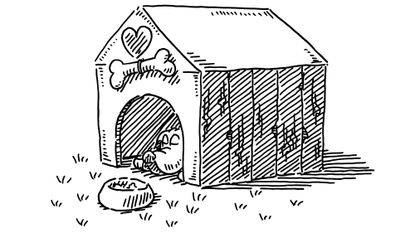5 most expensive dogs to insure
Your choice of dog breed can affect your insurance premiums - these are the most expensive dogs to insure and why


Pet insurance is essential if you don’t want to pay a large vets bill every time your dog becomes ill or has an accident. What breed your dog is will affect the cost of insurance.
This is because different breeds tend to have different genetic dispositions to certain health conditions. Some of these conditions will be expensive to treat and require ongoing care. Its these medical ailments which push up the cost of pet insurance.
According to Pets4Homes these are the top five most expensive dogs to insure.
(MORE: Pet insurance for puppies)
Dogue de Bordeaux
The Dogue de Bordeaux, France’s native mastiff, is a large breed prone to a wide range of potential health problems, many with a hereditary element. The average lifespan of the Dogue de Bordeaux is just seven or eight years, with dogs reaching the age of 10 only in rare cases.
The combination of size, a short lifespan and the likelihood poor health makes the Dogue de Bordeaux the most dog expensive to insure.
Great Dane
As the name suggests, Great Danes are big. All other factors aside, this makes this breed pricey to insure.
Look After My Bills Newsletter
Get the best money-saving tips, tricks and deals sent straight to your inbox every week. Make sense of your money in partnership with The Money Edit.
As with all larger dogs, Great Danes are prone to health issues and a shorter lifespan. In particular, they are likely to suffer from hip and elbow dysplasia, gastric dilatation volvulus (where the stomach twists) and certain cancers.
English bulldog
Although not a giant breed, the English bulldog is another dog with a short lifespan, typically six to eight years. Typical health conditions experienced by bulldogs include breathing troubles associated with the dogs' facial structure, and complications because of their layered skin.
Many of these issues come about due to unethical breeding and in-breeding, and a lack of diversity in the gene pool for this breed. English Bulldogs can be expensive to buy too as bulldogs tend to deliver small litters, with pups often delivered by caesarean section.
Bull Mastiffs
Bull Mastiffs are large but gentle dogs which become attached to, and protective of, their owners. They are likely to suffer separation anxiety more than many other breeds. They have a relatively short lifespan of about seven or eight years.
Bull Mastiffs’ shorter faces mean they often suffer from brachycephalic obstructive airway syndrome which causes breathing problems. Hip, elbow and joint problems are all common too, as well as a range of skin conditions.
Newfoundland
Newfoundlands are another giant breed with a relatively short lifespan. They tend to be prone to hip and elbow problems, dental issues, obesity, infections, bloats and parasite infections. The cost of treating a large dog with these conditions can be high, so this breed is another one that’s pricey to insure.
What else affects the price of insuring your dog?
It’s not just the breed that affects the price of insuring your dog. Size is another big factor – proven by the fact that four out of the five most expensive breeds to insure are ‘giant’ breeds. For large dogs, surgery can cost up to twice as much and they’ll need higher doses of medication too.
The more health issues a certain dog is prone to, the more it will cost to insure. Whatever the breed, pedigrees tend to have more genetic illnesses compared to crossbreeds, and so cost more to insure.
Age is another factor – older dogs are more likely to become ill, so they are more expensive to cover than younger pups. Where you live can also have a big impact on the price you pay for pet insurance. In the UK vet treatment typically costs more in London and the South East than elsewhere.
Levels of insurance cover
The cheapest dog insurance policies only cover accidents. So, if your dog is hit by a car, it will cover the costs but you’re on your own if he or she develops a health condition.
‘Time-limited’ policies offer a set amount of money towards treatment for an illness or injury over a 12-month period. But the pay-outs will stop when you reach either the cost limit or the time limit – whichever comes first.
A ‘maximum benefit’ policy will pay out a set amount in your dog’s lifetime for each illness or injury. If the condition still needs treatment when you’ve reached the cap, you’ll need to pay for it yourself.
A ‘lifetime’ insurance policy is the most comprehensive cover option, and therefore the most expensive. It gives you a maximum claim limit, per condition, per year. You’ll be covered for new and ongoing conditions if you keep renewing the policy each year.
Emma Lunn is an award-winning freelance financial journalist who specialises in money and consumer affairs. She has more than 17 years’ experience writing for national newspapers, trade and consumer magazines, and specialist websites. She has a particular interest in writing about property and mortgages, and enjoys explaining complex issues in an easy-to-understand way.
-
 Three energy firms pay £8m in switching compensation - has your provider paid out?
Three energy firms pay £8m in switching compensation - has your provider paid out?More than 100,000 customers have received compensation after changing providers, but is now a good time to switch energy suppliers?
By Tom Higgins Published
-
 Save £300 on your supermarket shop with cashback accounts
Save £300 on your supermarket shop with cashback accountsBanks, credit card companies and cashback sites are all offering cashback on your supermarket shop, but can you use them all to max out your savings?
By Vaishali Varu Published
-
 Travel insurance: what to look for when buying travel cover this Easter
Travel insurance: what to look for when buying travel cover this EasterBuying travel insurance can seem like one more job on your holiday ‘to do’ list, but it’s important you don’t leave home without it. We explain what to look for when shopping around for the best deal
By Sue Hayward Published
-
 Missed flight cover: when can you claim if you miss your plane?
Missed flight cover: when can you claim if you miss your plane?Bad weather, traffic jams, breaking down or not having a valid passport could all mean you can’t get as far as the airport – we look at whether your travel insurance will pay up
By Sue Hayward Published
-
 Six reasons your home insurance could be refused, cancelled or voided
Six reasons your home insurance could be refused, cancelled or voidedCheck your policy and read the small print to ensure your home insurance is not refused, cancelled or voided
By Sue Hayward Last updated
-
 Average price paid for home insurance ‘at lowest levels in at least a decade’
Average price paid for home insurance ‘at lowest levels in at least a decade’The average cost of home insurance in 2022 was £300 - how does your premium compare?
By Katie Binns Published
-
 Revealed: the job titles that add £100s to car insurance - and the cheaper alternatives
Revealed: the job titles that add £100s to car insurance - and the cheaper alternativesJob titles that will see the biggest rise in car insurance costs in 2023 have been revealed - is your job title one of them? And how to find cheaper alternatives
By Vaishali Varu Published
-
 How to avoid sneaky car insurance fees
How to avoid sneaky car insurance feesSome motor insurers are increasing fees and charges for motorists. We reveal how to avoid them
By Sue Hayward Last updated
-
 How to get cheap car insurance: 10 ways to cut the cost
How to get cheap car insurance: 10 ways to cut the costIf you’re a driver, you can’t hide from paying for car insurance but knowing how to get cheap car insurance can cut the cost without compromising cover quality.
By Vaishali Varu Published
-
 Amazon sells insurance: is comparing and buying an insurance policy through Amazon any good?
Amazon sells insurance: is comparing and buying an insurance policy through Amazon any good?Amazon Insurance Store launches in the UK to sell home insurance
By Sue Hayward Published